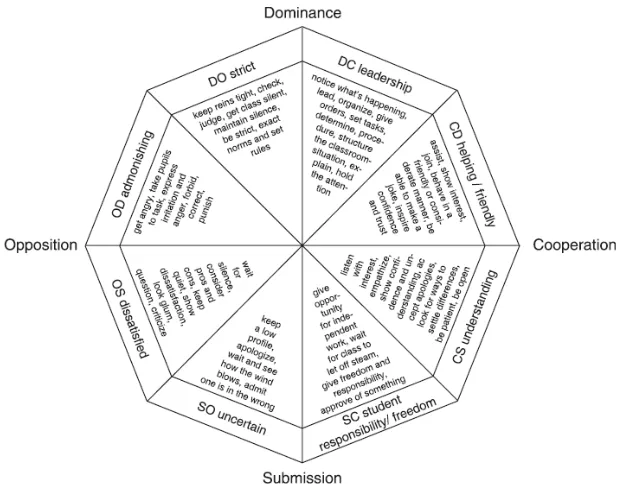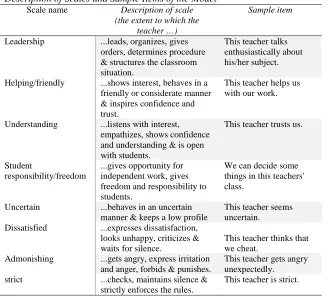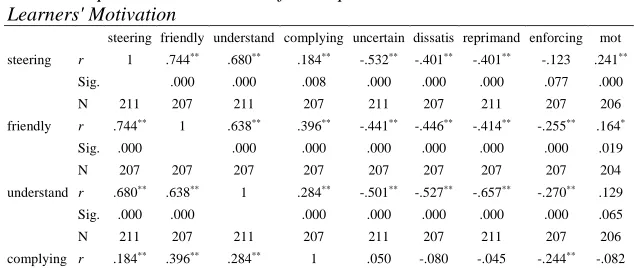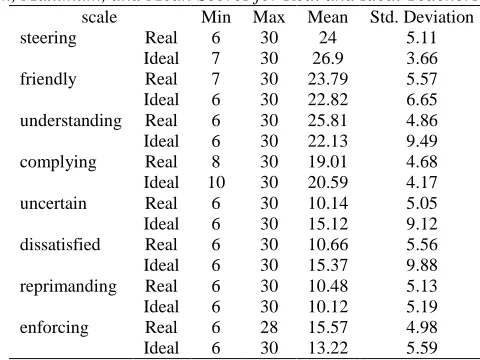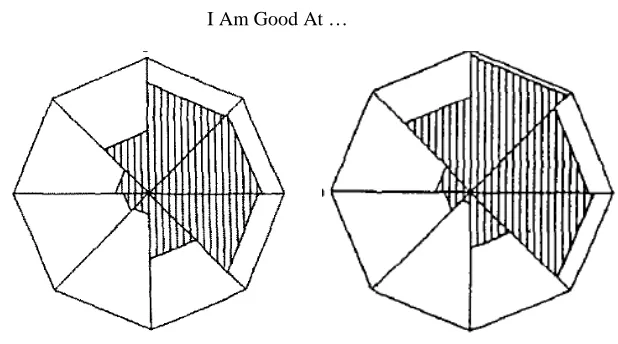I Am Good at It Because I Like Its Teacher: To
what Extent Does Teacher Behaviour Motivate
Students to Learn?
Hajar Ghafarpour
1PhD. Candidate, Department of Foreign Languages, University of
Isfahan, Iran
Ahmad Moinzadeh
Associate Professor, Department of Foreign Languages, University of
Isfahan, Iran
Abbas Eslamirasekh
Associate Professor, Department of Foreign Languages, University of
Isfahan, Iran
Abstract
The teachers' behaviors sometimes have a more intense and long-lasting influence than the information being transmitted; meanwhile, the concentration of much of the curriculum of teacher education has just been on the course content or teaching methods. In this study, the relationship between students' motivation and teachers' behavior is investigated based on the Model for Interpersonal Teacher Behavior (MITB). The questionnaires were distributed to 211 students of eight classes of general English course at the University of Isfahan. Results indicated that among the eight scales of the model, students' motivation is significantly positively correlated with the friendly scale, and significantly negatively correlated with dissatisfied, and reprimanding scales. This may have cultural and psychological implications. Furthermore, some modifications on the graphical presentation of the MITB are proposed and a model for an ideal English teacher in Iran is obtained and compared cross-culturally.
Keywords: Ideal Teacher, Model for Interpersonal Teacher Behavior, Motivation, Proximity
Received on 25 March, 2017 Accepted on October 22, 2018
1. Introduction
Interaction has proved to play a significant role in the process of learning, especially second language acquisition. The advent of communicative
language teaching further highlighted the significance of interaction (Brown, 2007). Furthermore, interaction is now perceived to promote the processing capacity of learners (Walsh, 2002; Matsumoto, 2010). As anybody might have experienced, one's motivation and achievement in a course may be heavily dependent on and influenced by the teacher's behavior and the interactive atmosphere of the class (den Brok, Berkelmans & Wubbles, 2004 & 2005; Maulanaa, Opdenakkera, den Brokb & Bosker, 2011; Nugent, 2009; Passini, Molinary & Speltini, 2015; Urhahne, 2015; Wei & Onsawad, 2007; Wei, Zhou, Barber & den Brok, 2015). In fact, according to Whitaker (2004), teachers should be aware of the importance of connecting with their students; they can hardly influence students' minds if they cannot establish a proper connection with them. He believes that although there have been countless reforms, educational movements, and programs all undertaken to improve education, no factor can be as profound and influential as the human element. Students' perceptions of their teachers' competence, care, support, and the nature of the teacher-student relationship affect their motivation and achievement (Stipek, 2002).
The interactive state of the class influences not only learners' motivation, but also their achievement. According to Stipek (2002) many of students who do not perform well academically, are those who have a poor rapport with their teachers. Often, the more they lag, the more this relationship is enfeebled; conversely, students who perceive this relationship to be more encouraging, tend to develop better attitudes and may desire to maintain this relationship or please the teacher by doing well in class. They often perform better in comparison with other students who lack the same support.
Berkelmans & Wubbles, 2004). The major cause of this difference is differences between teachers. According to Whitaker (2004), in the classroom the main variable is the teacher and not the student. Great teachers expect much from their students, but even more from themselves. Obviously, the concepts of effective teaching and effective teacher vary from era to era. This makes the need to search for effective teaching attributes to be an ongoing process. Thus, it can be claimed that teachers of the present era need to be knowledgeable and competent not only as instructors but also as leaders and counselors (Falls, 1999).
Despite these facts and irrespective of the importance of teacher behavior on learners' motivation and achievement, much of the curriculum of teacher education programs has focused on content or teaching methods and very little attention is being paid to the interpersonal relationships that exist between teachers and their students (Higgins, 2011). Therefore, many teachers start their job when they have just minor or no idea of the definitive role that they play in developing interpersonal relationships.
2. Literature Review
The effect of motivation on learning, especially a second language has been well-established since 1959 by dominant researchers such as Dörnyei (1998, 2005, 2009), Dörnyei and Schmidt (2001), Gardner (1959, 2004, 2008) and Oxford (1996). Gardner, in his original socio-educational model (1985) proposed that aptitude and motivation are two primary factors affecting language learners' performance. Among these two, motivation has a more central role. Based on this model, the motivational factors occur in sites where L2 learning takes place. Hence, Gardner points at the significance of the educational context as the formal site where L2 learning takes place.
The role of teacher in motivating learners is also highlighted through the social-constructivist model of motivation since in this model there are four key elements influencing teaching-learning process. These elements include learner(s), teacher, task, and context (Williams & Burden, 1997). The framework in this model emphasized contextual influences and categorized motivational factors as learner-internal or external factors with teachers being learner external factors (Dörnyei & Ushioda, 2013).
teachers are responsible for establishing the fundamental motivational conditions. They should also generate and maintain student motivation.
However, regarding teachers' behaviors much of the past research on classroom interaction focused on a teacher's specific behaviors, counting how frequently each one occurred and then building a description for effective teaching by combining discrete behaviors. However, according to Tuckman (1995) there is an alternative approach which is more holistic and personal, wherein the teacher is regarded not as a teaching device, but as a person, a human being with his or her own interpersonal style and identifiable affective behaviors. As teaching is an interpersonal process, interpersonal style cannot be detached from it.
The two dimensions can be represented as two axes which denote eight types of behaviors, namely leading, helpful/friendly, understanding, student responsibility and freedom, uncertain, dissatisfied, admonishing and strict. Figure 1 presents an overview of generic teacher behaviors that relate to the model by Wubbels, Brekelmans, and Hooymayers (1991) and Table 1 provides a description on scales and some sample items of for each scale by Fisher, Rickards, and Newby (2001).
Table 1
Description of Scales and Sample Items of the Model
Scale name Description of scale
(the extent to which the teacher …)
Sample item
Leadership ...leads, organizes, gives
orders, determines procedure & structures the classroom situation.
This teacher talks enthusiastically about his/her subject.
Helping/friendly ...shows interest, behaves in a
friendly or considerate manner & inspires confidence and trust.
This teacher helps us with our work.
Understanding ...listens with interest,
empathizes, shows confidence and understanding & is open with students.
This teacher trusts us.
Student
responsibility/freedom
...gives opportunity for independent work, gives freedom and responsibility to students.
We can decide some things in this teachers' class.
Uncertain ...behaves in an uncertain
manner & keeps a low profile
This teacher seems uncertain.
Dissatisfied ...expresses dissatisfaction,
looks unhappy, criticizes & waits for silence.
This teacher thinks that we cheat.
Admonishing ...gets angry, express irritation
and anger, forbids & punishes.
This teacher gets angry unexpectedly.
strict ...checks, maintains silence &
strictly enforces the rules.
This teacher is strict.
Different names have already been proposed for these eight scales; for instance, Wubbels et al. (2012) have used the terms steering, complying, reprimanding, and enforcing instead of leadership, student responsibility/ freedom, admonishing and strict, respectively. As these seem to be more proper dictions, these names are used in this study. Therefore, the eight scales are: steering, friendly, understanding, complying, uncertain, dissatisfied, reprimanding, and enforcing as in Wubbles et al. (2012).
Berkelmans and Wubbles (2004) and Wei and Onsawad (2007). As cited in Wubbles and Berkelmans (2005), Brekelmans' (1989) study indicated that there was a positive correlation between students' perceptions of teacher influence and their cognitive outcomes.
A positive relationship of both influence and proximity have been found between the teacher–student relationships and affective outcomes (Maulanaa et al., 2011; Nugent, 2009; Urhahne, 2015). Generally, proximity is somewhat more influential than influence. The motivation of students is higher if they have a higher perception of proximity.
Other studies such as den Brok, Berkelmans and Wubbles (2005) done on subject-specific motivation found that teacher proximity strongly and positively influenced all diagnosed subject-related attitude variables. In addition, influence had a positive effect on three of the outcome variables, namely pleasure, relevance and effort, too. Overall, however, proximity seemed to have a greater impact than influence.
3. Methodology
Students' motivation was measured by using the Motivated Strategies for Learning Survey (MSLQ) and their perceptions on teachers' interactional behavior were measured and analyzed via the Questionnaire on Teacher Interaction (QTI). Students were also asked to rate the QTI for an ideal teacher so that a role model can be obtained. Demographic information on the age, gender, and perceived level of English proficiency was obtained from the learners.
3.1 Participants
The questionnaires were distributed to 211 students of eight classes of general English course at the University of Isfahan, Iran. Classes consisted of at least 21 or at most 32 students. The students' age range was 18-24 with an average of 19. About 44% of the students were female and 56% were male. The age range of instructors was 30-45 with at least five years of experience of teaching English at the university level.
3.2 Instruments
The quick version of the Motivated Strategies for Learning Survey (MSLQ) and student version of Questionnaire on Teacher Interaction (QTI) are used to investigate learners' motivation and interpersonal teachers’ behaviors, respectively.
3.2.1 MSLQ
according to Arnito (2005), students' motivation is positively related to their ability in self-regulating their learning activities and self-regulated learning is deemed to be metacognitively, motivationally, and behaviorally functioning in one's learning processes and in achieving goals. Here, motivation and learning strategies are not regarded as static characteristics of the learner, but as dynamic and contextually bound traits. Learning strategies can be learned and brought under the control of the student; in other words, students' motivations change from one course to another, and accordingly the learning strategies they apply may vary, depending on the nature of the course.
MSLQ was developed by Pintrich, Smith, Garcia, and McKeachie (1991) but its formal development started in 1986 by McKeachie and Pintrich. Since then, it has undergone numerous revisions. As is reported in Nuget (2009) various versions of it has undergone statistical and psychometric analyses. The Cronbach's alphas are strong and range from 0.52 to 0.93. Additionally, its factor validity has been established through factor analyses provided in its manual.
3.2.2 QTI
Several studies have been done to investigate the reliability and validity of different versions of QTI. These have included American (Wubbels & Levy, 1991), Australian (Fisher, Henderson and Fraser, 1995), and Dutch (den Brok, 2001). Also, a cross-national validity study was conducted in Singapore, Brunei, US, the Netherlands, Slovakia and Australia (den Brok et al., 2003). It has also been applied in the Chinese context by Wei et al. (2015).
3.3 Data Analysis
For the QTI questionnaire a 5-point Likert scale was used to indicate agreement by responses of 'Never' (1), 'Almost never' (2), 'Neutral' (3), 'Almost always' (4), and 'Always' (5). Items relating to each subscale and domain are presented in Table 2.
Table 2
Items Relating to Each SubScale and Domain in the QTI
Domain Subscale Question numbers
Dominance Steering 1,5,9,13,17, 21 Enforcing 28, 32, 36, 40, 44, 48 Cooperation Uncertain 3, 7, 11, 15, 19, 23
Complying 26, 30, 34, 38, 42, 46 Submission Friendly 25, 29, 33, 37, 41, 45
Understanding 2, 6, 10, 14, 18, 22 Opposition Dissatisfied 27, 31, 35, 39, 43, 47
Reprimanding 4, 8, 12, 16, 20, 24
For each subscale the minimum score is six, when a student rates the teacher 1 for all the six items, and the maximum is 30, when the scores of all the six items is 5. Then, the mean of each subscale is obtained from the ratings of all students.
MSLQ score for each student represented his/her motivation. The higher the score, the more study skills the student used.
To investigate whether there is a relationship between teachers' interactional behavior and learners' motivation, a Pearson product moment r correlation was conducted. Before running the correlation, box plots were used to test outliers of both the MSLQ and the QTI. Outliers were identified and removed. This was crucial because the Pearson correlation is highly sensitive to these extreme values.
4. Results
Data were analyzed for both the actual teacher and the ideal one, the results of which will be first presented separately and then they will be compared together.
4.1 Actual Teacher
Cronbach's alpha showed that the questionnaire had an acceptable reliability of 0.81. The data on the perceptions of learners about their actual teacher were analyzed for outliers by box plot. After identifying outliers, they were eliminated and Pearson product moment r correlation was used to investigate the relationship between the scales of interpersonal teacher behavior and learners' motivation. The result is presented in Table 3.
Table 3
Relationship Between Scales of Interpersonal Teacher Behaviour and Learners' Motivation
steering friendly understand complying uncertain dissatis reprimand enforcing mot steering r 1 .744** .680** .184** -.532** -.401** -.401** -.123 .241**
Sig. .000 .000 .008 .000 .000 .000 .077 .000
N 211 207 211 207 211 207 211 207 206
friendly r .744** 1 .638** .396** -.441** -.446** -.414** -.255** .164*
Sig. .000 .000 .000 .000 .000 .000 .000 .019
N 207 207 207 207 207 207 207 207 204
understand r .680** .638** 1 .284** -.501** -.527** -.657** -.270** .129
Sig. .000 .000 .000 .000 .000 .000 .000 .065
N 211 207 211 207 211 207 211 207 206
Sig. .008 .000 .000 .478 .253 .517 .000 .241
N 207 207 207 207 207 207 207 207 204
uncertain r -.532** -.441** -.501** .050 1 .707** .659** .330** -.236**
Sig. .000 .000 .000 .478 .000 .000 .000 .001
N 211 207 211 207 211 207 211 207 206
dissatis r -.401** -.446** -.527** -.080 .707** 1 .702** .562** -.148*
Sig. .000 .000 .000 .253 .000 .000 .000 .035
N 207 207 207 207 207 207 207 207 204
reprimand r -.401** -.414** -.657** -.045 .659** .702** 1 .338** -.158*
Sig. .000 .000 .000 .517 .000 .000 .000 .024
N 211 207 211 207 211 207 211 207 206
enforcing r -.123 -.255** -.270** -.244** .330** .562** .338** 1 -.067
Sig. .077 .000 .000 .000 .000 .000 .000 .344
N 207 207 207 207 207 207 207 207 204
motivation r .241** .164* .129 -.082 -.236** -.148* -.158* -.067 1
Sig. .000 .019 .065 .241 .001 .035 .024 .344
N 206 204 206 204 206 204 206 204 206
**. Correlation is significant at the 0.01 level (2-tailed). *. Correlation is significant at the 0.05 level (2-tailed).
4.2 Ideal Teacher
The data gathered for the ideal teacher via the same QTI were probed for outliers by boxplot. Interestingly, there are more outliers in data for the ideal teacher than for the actual one. As the students mark for the actual and ideal teacher simultaneously and the entered data are checked by two experts, this increased number of outliers may indicate that learners are more uncertain about their role model. After identifying outliers, they were deleted. Table 4 shows minimum, maximum, and mean scores for the real and the role model teacher.
Table 4
Minimum, Maximum, and Mean Scores for Real and Ideal Teachers
scale Min Max Mean Std. Deviation
steering Real 6 30 24 5.11
Ideal 7 30 26.9 3.66
friendly Real 7 30 23.79 5.57
Ideal 6 30 22.82 6.65
understanding Real 6 30 25.81 4.86
Ideal 6 30 22.13 9.49
complying Real 8 30 19.01 4.68
Ideal 10 30 20.59 4.17
uncertain Real 6 30 10.14 5.05
Ideal 6 30 15.12 9.12
dissatisfied Real 6 30 10.66 5.56
Ideal 6 30 15.37 9.88
reprimanding Real 6 30 10.48 5.13
Ideal 6 30 10.12 5.19
enforcing Real 6 28 15.57 4.98
Ideal 6 30 13.22 5.59
5. Discussion and Conclusion
According to Wubbles and Berkelmans (2005) generally the effects of proximity are somewhat stronger than those of influence, which means if the proximity is perceived to be higher, the motivation of the students will be higher. That was also true for this study, except for the complying scale that is negatively correlated with motivation. This indicates that in the present context being too much complying affects motivation negatively.
In previous studies, strong and positive associations have been detected between affective outcomes and teacher interpersonal behavior and/or some of its scales such as leading and helpful/friendly while this relationship have been found to be negative for other scales, namely admonishing, dissatisfied, and, in most cases, strict (Fisher & Rickards, 1998; Nuget, 2009; Wubbles & Berkelmans, 2005; Wei et al., 2015).
Figure 2. American teacher role model Figure 3. Dutch teacher role model
The ideal teacher in Iran is not as steering as the Dutch one. The pattern for proximity positive scales is more or less similar in the three contexts; meanwhile, for the proximity negative scales conspicuous differences can be observed among the Iranian and the other two models. In the latter two contexts the least scores of the proximity negative scales are related to the uncertain scales; however, in the Iranian context, surprisingly, a relatively higher level of uncertainty is allowed for the ideal teacher. In the Iranian model the lowest level is related to the reprimanding scale whereas in the Chinese model the least score is related to the dissatisfied scale. These may indeed have cultural, psychological and ideological basis that need to be further investigated.
culturally stereotyped learning environments that were teacher-centered and teacher-controlled. This is contrary to the Iranian model in which the steering scale is dominant, and students do not require a high degree of strictness. This may indicate that Iranian students are more collectivist and also reprimanding a student may mean reprimanding the whole class.
The original model is in the form of a hexagon; however, if any radius in each sector is to represent the same score, a circular model is preferable. Additionally, the minimum score is 6, that is if a teacher is scored 6 on a scale like strict, this shows that the teacher is not strict and there is absence of strictness; so, the inner circle with a radius of 6 should be left empty; otherwise the graph shows that that teacher has an amount of strictness. Therefore, model for the ideal teacher in the context of the present study would be something like Figure 4.
To conclude, the results of the study can be used extensively in promoting the communicative ground of the class. This can lead to enhancing the quality of the relationship that exist between teachers and learners and finally motivating learners. As there is a close relationship between teachers and learners, enriching the interactive ground of the classroom will help all learners, especially those students who are shy by promoting their self-esteem and self-determination. Learners will be encouraged to participate more actively in the class and ultimately the educational outcome will be elevated. These results can also be applied in training teachers for their professional development. The QTI which was proved to be a valuable tool in research and teacher education in various contexts, especially because of its strong theoretical framework, is ascertained to be reliable and valid in Iranian EFL context as well. As learners in some courses may be more sensitive to teachers' interpersonal behaviours the interdisciplinary variations can be another issue to be investigated to enhance the overall educational outcome. Furthermore, as behaviours are context and culture-dependent cross cultural differences can also be taken into consideration for further research.
References
Artino, Anthony R., JR. (2005). Review of the motivated strategies for learning questionnaire. (ERIC Document Reproduction in Service No. ED499083).
den Brok, P. (2001). Teaching and student outcomes. A study on teachers' thoughts and actions from an interpersonal and a learning activities perspective. Utrecht: W.C.C.
den Brok, P., Berkelmans, D., & Wubbles, Th. (2004). Interpersonal Teacher Behaviour and Student Outcomes. School Effectiveness and School Improvement, 15(3–4), 407–442.
den Brok, P., Berkelmans, D., & Wubbles, Th. (2005). The effect of teacher interpersonal behaviour on Students' subject-specific motivation. Journal of Classroom Interaction, 40(2), 20–33.
den Brok, P., Levy, J., Wubbels, Th., & Rodriguez, M. (2003). Cultural influences on students’ perceptions of videotaped lessons. International Journal of Intercultural Relations, 27, 355–374.
Den Brok, L., Taconis, R., & Fisher, D. (2010). How well do science teachers do? Differences in teacher-student interpersonal behaviour between science teachers and teachers of other (school) subjects. Open Education Journal, 3, 44-53
Brown, H. D. (2007). Principles of language learning and teaching. NY: Pearson Longman.
Charalampous, K. & Kokkinos, M.K. (2013). The model of interpersonal teacher behaviour: a qualitative cross-cultural validation within the Greek elementary education context. British educational research journal, 39(1). 182-205.
Dörnyei, Z. (1998). Motivation in second and foreign language learning. Language Teaching, 31 (3), 117-135.
Dörnyei, Z. (2005). The psychology of the language learner: Individual differences in second language acquisition. Mahwah, NJ: Lawrence Erlbaum.
Dörnyei, Z. (2009). The psychology of second language acquisition. Oxford: Oxford University Press.
Dörnyei, Z., & Otto, I. (1998). Motivation in action: A process model of L2 motivation. Working papers in applied linguistics, 4, 43-69.
Dörnyei, Z., & Schmidt, R. (Eds). (2001). Motivation and second language acquisition. University of Hawaii Press, HI.
Dörnyei, Z., & Ushioda, E. (2013). Teaching and researching: Motivation. New York: Routledge.
Fisher, D. L., Henderson, D., & Fraser, B. J. (1995). Interpersonal behaviour in senior high school biology classes. Research in Science Education, 25, 125–133.
Fisher, D. & Rickards, T. (1998). Associations between teacher-student interpersonal behaviour and student attitude to mathematics. Mathematics Education Research Journal, 10(1), 3-15.
Fisher, D., Rickards, T. & Newby, M. (2001). A multi-level model of classroom interaction using teacher and student perceptions. Paper presented at Annual Conference of the Australian Association for Research in Education, Perth, 2001.
Gardner, R. C., & Lambert, W. E. (1959). "Motivational variables in second-language acquisition". Canadian Journal of Psychology. 13: 266–272. Gardner, R. C. (1985). Social psychology and second language learning: The
role of attitudes and motivation. London: Edward Arnold.
Gardner, R. C. (2004). Attitude/motivation test battery: International AMTB research project. Canada: The University of Western Ontario.
Higgins, C. S. (2011). Teacher-student relationship development: a qualitative study of interpersonal connections in an early childhood classroom (Unpublished doctoral dissertation). College of education and human ecology, the Ohio State University.
Falls, HL. (1999). Teachers' perceptions of their roles as generalist: a study of the interpersonal skills necessary for effective leadership and counseling (Unpublished doctoral dissertation). Virginia Polytechnic Institute and State University.
Matsumoto, H. (2010). Students’ perceptions about teacher talk in Japanese as a second language classes. Arizona Working Papers in SLA & Teaching, 17, 53-74.
Maulanaa, R., Opdenakkera, M.C., den Brokb P., & Bosker, R. (2011). Teacher–student interpersonal relationships in Indonesia: profiles and importance to student motivation. Asia Pacific Journal of Education, 31(1), 33–49.
Nugent, T. (2009). The impact of teacher-student interaction on student motivation and achievement (Unpublished doctoral dissertation). College of Education, the University of Central Florida.
Oxford, R.L. (Ed). (1996). Language learning motivation: Pathways to the new century. University of Hawaii Press, HI.
Passini, S., Molinari, L., & Speltini, G. (2015). A validation of the questionnaire on teacher interaction in Italian secondary school students: the effect of positive relations on motivation and academic achievement. Social psychological education, 18, 547–559.
Pintrich, P. R., Smith, D. A., Garcia, T., & McKeachie, W. J. (1991). A manual for the use of the motivated strategies for learning questionnaire (MSLQ) (Report No. NCRIPTAL-91-B-004). Washington DC: Office of Educational Research and Improvement. (ERIC Document Reproduction Service No. ED338122).
Stipek, D. (2002). Motivation to learn: Integrating theory and practice. Boston, Massachusetts: Allyn and Bacon.
Tuckman, Bruce W. (1995). The interpersonal teacher model. The educational forum, 59.
Urhahne, D. (2015). Teacher behaviour as a mediator of the relationship between teacher judgment and students' motivation and emotion. Teaching and Teacher Education, 45, 73-82.
Walsh, S. (2002). Construction or obstruction: Teacher talk and learner involvement in the EFL classroom. Language Teaching Research, 6(1), 3-23.
Wei, M., & Onsawad, A. (2007). English teachers' actual and ideal interpersonal behaviour and student's outcome in secondary schools of Thailand. The Journal of Asia TEFL, 4(2), 95-121.
Whitaker, T. (2004). What great principals do differently. Larchmont, NY: Eye on Education, Inc.
Williams, M., & Burden, R. L. (1997). Psychology for teachers. Cambridge: Cambridge University Press.
Wubbels, T., Brekelmans, M., den Brok, P., Levy, J., Mainhard, T., and van Tartwijk, J. (2012). Let's make things better. In P. J. den Brok, J. van Tartwijk, J. Levy, & T. Wubbels (Eds.), Interpersonal relationships in education: An overview of contemporary research (pp. 225–249). Rotterdam: Sense Publishers.
Wubbels, Th., Brekelmans, M. (2005). Two decades of research on teacher-student relationships in class. Journal of educational research, 43, 6-24. Wubbels, Th., Brekelmans, M., & Hooymayers, H. (1991). Interpersonal
teacher behaviour in the classroom. In B. J. Fraser & H. J. Walberg (Eds.), Educational environments: Evaluation, antecedents and consequences (pp. 141-160). Oxford, England: Pergamon Press.
Wubbels, Th., Créton, H. A. & Hooymayers, H. P. (1985). Discipline problems of beginning teachers, interactional teacher behaviour mapped out. Abstracted in Resources in Education, 20(12), 153. (ERIC document 260040)
